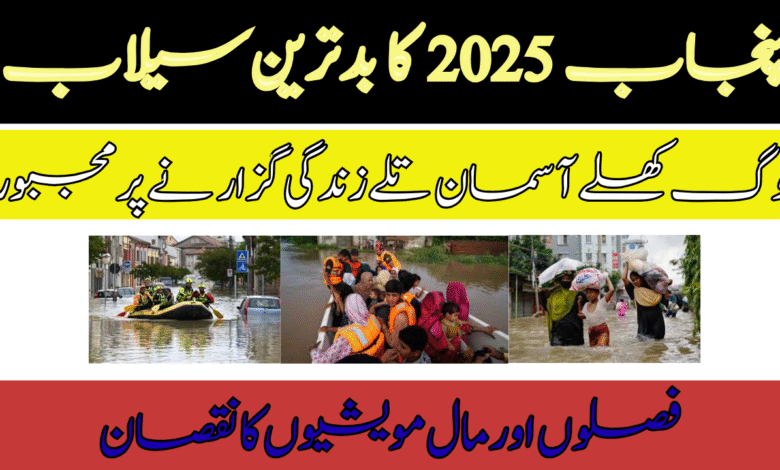Punjab Floods 2025: Pakistan’s Worst Monsoon Disaster in History
پنجاب 2025 کا بدترین سیلاب – تباہی اور غفلت کی پوری کہانی

The year 2025 has turned into one of the most devastating periods in Pakistan’s recent history. The province of Punjab, known as the “breadbasket of Pakistan,” is drowning under the weight of the worst floods in decades. Relentless monsoon rains, combined with sudden water releases from upstream dams in India, have displaced over 2 million people, destroyed thousands of homes, and wiped out crops that feed millions.
Entire villages now look like islands surrounded by murky waters, and desperate families are clinging to whatever hope they can find. The situation is being described by climate experts as a “once-in-a-century disaster”, but for Pakistan, such events are becoming alarmingly frequent.
This catastrophe is more than a natural disaster; it’s a symptom of a growing climate crisis that Pakistan cannot afford to ignore. It highlights the urgent need for better disaster planning, resilient infrastructure, and international cooperation to save lives and livelihoods.
In this article, we’ll explore the causes, impacts, and relief efforts, along with the lessons Pakistan must learn to prepare for a future where such disasters could become the new normal.
یہ صرف ایک قدرتی آفت نہیں بلکہ کلائمیٹ چینج کی سخت وارننگ ہے۔ ہمیں بہتر ڈیزاسٹر پلاننگ، مضبوط انفراسٹرکچر، اور ماحول دوست اقدامات کی فوری ضرورت ہے تاکہ آئندہ اس طرح کی تباہی سے بچا جا سکے۔
Causes of the Punjab Floods 2025
- Unprecedented Monsoon Rains
Rainfall records shattered this year, flooding rivers like Sutlej, Ravi, and Chenab far beyond their banks. - Sudden Water Release from India
Emergency releases from upstream dams intensified water levels, leaving communities with no time to prepare. - Climate Change at Play
Rising global temperatures are causing unpredictable weather, heavier monsoons, and rapid glacial melting in the north. - Weak Infrastructure
Aging embankments, poor drainage systems, and lack of flood-resilient dams worsened the destruction.
Human and Economic Impact
- Over 2 Million People Displaced – Families are living in temporary shelters without clean water or proper sanitation.
- Crops and Livelihoods Destroyed – Punjab’s fertile lands, which support the nation’s food supply, have suffered catastrophic losses worth billions.
- Public Health Emergency – Outbreaks of cholera, skin infections, and waterborne diseases are spreading rapidly.
- Education Halted – Hundreds of schools are either submerged or converted into emergency shelters.
- Rising Poverty and Debt – Farmers and laborers are struggling to recover as their savings and assets wash away.
Relief Efforts and On-Ground Challenges
- Government Rescue Missions
Emergency teams are working around the clock, but many remote villages remain inaccessible. - Community and NGO Support
Local volunteers, private charities, and NGOs are providing food, medicine, and clean water where official relief is delayed. - International Assistance
Global organizations and friendly nations are offering funds, medical teams, and disaster recovery expertise. - Major Challenges
Poor coordination, damaged roads, and lack of transport facilities are slowing down the aid response.
Lessons Pakistan Must Learn
- Invest in Flood-Resilient Infrastructure – Strong embankments, modern drainage systems, and new dams are urgently needed.
- Improve Disaster Preparedness – Early warning systems and community training can save thousands of lives.
- Address Climate Change Locally – Tree plantations, water management, and sustainable urban planning are critical.
- Regional Water Cooperation – Transparent, cooperative water-sharing policies with India can prevent future crises.
- Build Community Resilience – Education and awareness programs can help communities prepare for emergencies.
Conclusion
The Punjab Floods of 2025 are a national tragedy and a global warning. Pakistan contributes less than 1% of global emissions, yet it remains one of the countries most vulnerable to climate disasters. The road to recovery will be long and painful, but it also offers an opportunity to rebuild stronger, safer, and smarter.
This disaster should push policymakers, communities, and the international community to come together—not just for immediate relief but to invest in long-term solutions. The cost of inaction will only rise, and the people of Pakistan cannot afford another tragedy of this scale.